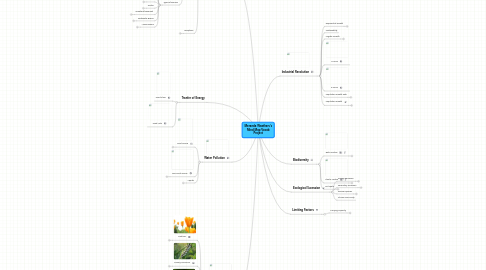
1. Levels of Organization
1.1. Organism
1.1.1. A bumble bee is a type of organism for it lives.
1.1.2. Definition: Any form of life.
1.2. Population
1.2.1. In a classroom there is a large group of people. These people together can be considered a population for they are the same organism.
1.2.2. Definition: A group of individuals of the same species found in a given area or located in the same areas at a given time.
1.3. Community
1.3.1. One example of a community is birds, insects, and trees. The birds interact with the insects by consuming then and the insects interact with the trees by eating their leaves and residing within their trunk.
1.3.2. Definition: Populations of living organisms benefits while one organisms that interact with one another in an ecosystem.
1.4. Ecosystem
1.4.1. A forest is an example of an ecosystem for there are diverse organisms with rocks and soils that interact with one another.
1.4.2. Definition: A group of living organisms that interact with one another and the non living physical enviroment as one unit.
1.5. Biome
1.5.1. Tempered Deciduous Forest is the biome that PA is located in.
1.5.2. Definition: A geographic region on Earth that is inhabited by a community of distinct types of plants and animal spieces.
1.5.3. Types of Biomes
1.5.3.1. Rainforest
1.5.3.1.1. Definition: A dense evergreen forest with an annual rainfall of at least 406 centimeters (160 inches). Rainforests are often, but not always, located in tropical regions
1.5.3.2. Tempered Deciduous Forest
1.5.3.2.1. Definition: A type of forest characterized by trees that seasonally shed their leaves.
1.5.3.3. Coniferous Forest
1.5.3.3.1. Definition: A type of forest characterized by cone-bearing, needle-leaved trees.
1.5.3.4. Desert
1.5.3.4.1. Definition: A region so arid because of little rainfall that it supports only sparse and widely spaced vegetation or no vegetation at all.
1.5.3.5. Tundra
1.5.3.5.1. Definition: One of the vast, nearly level, treeless plains of the arctic regions of europe, Asia, and North America.
1.5.3.6. Grassland/Savannah
1.5.3.6.1. Definition: An area, as a prairie, in which the natural vegetation consists largely of perennial grasses, characteristic of subhumid and semiarid climates.
1.5.3.7. Freshwater Biome
1.5.3.7.1. Definition: The aquatic biome consisting of water containing fewer salts than the waters in the marine biome; divided into two zones: running waters (rivers, streams) and standing waters (lakes, ponds.
1.5.3.8. Marine Biome
1.5.3.8.1. Definition: And aquatic biome that contains salt in its waters.
1.6. Biosphere
1.6.1. An example of a biosphere is the planet we live on Earth.
1.6.2. Definition: Layer of soil, water, and air that sustains life.
2. Tranfer of Energy
2.1. Food Chain
2.2. Food Web
3. Trophic Levels
3.1. Producer
3.1.1. Organisms that produce their own energy from the sun.
3.2. Primary Consumer
3.2.1. A consumer that eats producers.
3.3. Secondary Consumer
3.3.1. These organisms are eat primary consumers.
3.4. Tertiary Consumer
3.4.1. These organisms eat secondary consumers.
3.5. Quaternary Consumer
3.5.1. These consumers eat tertiary consumers.
4. Water Pollution
4.1. Point Source
4.1.1. Definition: A pollution source you can physically point at and show where it is coming from.
4.2. Non-Point Source
4.2.1. Definition: A pollution source that is from many different factors such as cars.
4.3. Aquifer
4.3.1. Definition: A body of permeable rock that can contain or transmit groundwater.
5. Biodiversity
5.1. Biotic Factors
5.1.1. Example: Turtle
5.2. Abiotic Factors
5.2.1. Example: Ocean Currents
5.3. Hot Spots
5.3.1. Definition: A place where most of the Earth's population is gathered. This is mostly around the equator.
6. Ecological Sucession
6.1. Primary Sucession
6.1.1. Definition: Succession that starts on bare rock that could be the result of erosion.
6.2. Secondary Sucession
6.2.1. Definition: Succession that starts after a natural disaster wiping out all life.
6.3. Pioneer Species
6.3.1. Definition: The first species that are to move into an ecosystem.
6.4. Climax Community
7. Limiting Factors
7.1. Carrying Capacity
7.1.1. Definition: The number of individuals of a species that and ecosystem can support.
8. Industrial Revolution
8.1. Exponential Growth
8.1.1. Definition: Rapid growth. Exsmple: 2(1.08)^3
8.2. Sustainability
8.3. Logistic Growth
8.3.1. Definition: A logistic growth curve is an S-shaped ( sigmoidal) curve that can be used to model functions that increase gradually.
8.4. J-Curve
8.5. S-Curve
8.6. Population Growth Rate
8.6.1. Definition: Population growth is the change in a population over time, and can be quantified as the change in the number of individuals of any species in a population using "per unit time" for measurement.
8.7. Population Growth
8.7.1. The Black Plague
